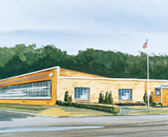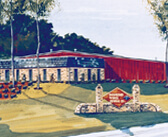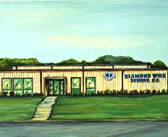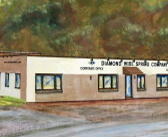
Glossary of Spring Terms
Glossary of Spring Terminology
Active coils (na)
Those coils which are free to deflect under load. For compression springs with squared ends, the total number of coils minus two is a good approximation of the number of active coils. For extension springs, the number of active coils is approximately equal to the number of coils in its body. For extension springs with threaded inserts or swivel hooks, the number of active coils is less than the total coils in the body. Hooks and loops add to the number of active coils.
Angular relationship of ends
The relative position of the plane of the hooks or loops of extension springs to each other.
Baking
Heating of electroplated springs to relieve hydrogen embrittlement.
Buckling
Bowing or lateral deflection of compression springs when compressed, related to the slenderness ratio (L/D).
Closed ends
Ends of compression springs where the pitch of the end coils is reduced so that the end coils touch.
Closed and ground ends
As with closed ends, except that the end is ground to provide a flat plane.
Closed length
See Solid Height.
Close-wound
Coiled with adjacent coils touching.
Coils per inch
See Pitch.
Deflection (F)
Motion of spring ends or arms under the application or removal of an external load (P).
Elastic limit
Maximum stress to which a material may be subjected without permanent set.
Endurance limit
Maximum stress to which any given material will operate indefinitely without failure for a given minimum stress.
Free angle
Angle between the arms of a torsion spring when the spring is not loaded.
Free length (L)
The overall length of a spring in the unloaded position.
Frequency (natural)
The lowest inherent rate of free vibration of a spring itself (usually in cycles per second) with ends restrained.
Gradient
See Rate (R).
Heat Setting
Fixturing a spring at elevated temperature to minimize loss of load at operating temperature.
Helix
The spiral form (open or closed) of compression, extension, and torsion springs.
Hooke’s Law
Load is proportional to displacement.
Hooks
Open loops or ends of extension springs.
Hot pressing
See Heat setting.
Hydrogen embrittlement
Hydrogen absorbed in electroplating or pickling of carbon steels, tends to make the spring material brittle and susceptible to cracking and failure, particularly under sustained loads.
Hysteresis
The mechanical energy loss that always occurs under cyclic loading and unloading of a spring, proportional to the area between the loading and unloading load-deflection curves within the elastic range of a spring.
Initial tension (Pi)
The force that tends to keep the coils of an extension spring closed and which must be overcome before the coils start to open.
Load (P)
The force applied to a spring that causes a deflection (F).
Loops
Coil-like wire shapes at the ends of extension springs that provide for attachment and force application.
Mean coil diameter (D)
Outside spring diameter (O.D.) minus one wire diameter (d).Modulus in shear or torsion (G) Coefficient of stiffness for extension and compression springs.
Modulus in tension or bending (E)
Coefficient of stiffness used for torsion and flat springs (Young’s Modulus).
Moment (M)
See Torque.
Open ends, not ground
End of a compression spring with a constant pitch for each coil.
Open ends ground
"Open ends, not ground" followed by an end grinding operation.
Passivating
Acid treatment of stainless steel to remove contaminants and improve corrosion resistance.
Permanent set
A material that is deflected so far that its elastic properties have been exceeded and it does not return to its original condition upon release of the load is said to have taken a "permanent set."
Pitch (p)
The distance from center to center of the wire in adjacent active coils. Recommended practice is to specify the number of active coils rather than the pitch.
Poisson’s Ratio
The ratio of the strain in the transverse direction to the strain in the longitudinal direction.
Preset
See Remove set.
Rate (R)
Change in load per unit deflection, generally given in pounds per inch (N/mm).
Remove set
The process of closing to solid height a compression spring that has been coiled longer than the desired finished length, so as to increase the apparent elastic limit.
Residual stress
Stresses induced by set removal, shot peening, cold working, forming or other means. These stresses may or may not be beneficial, depending on the application.
Set
Permanent distortion which occurs when a spring is stressed beyond the elastic limit of the material.
Shot peening
A cold-working process in which the material surface is peened to induce compressive stresses and thereby improve fatigue life.
Slenderness ratio
Ratio of spring length (L) to mean coil diameter (D).
Solid height (H)
Length of compression spring when under sufficient load to bring all coils into contact with adjacent coils.
Spring index
Ratio of mean coil diameter (D) to wire diameter (d).
Squared and ground ends
See Closed and ground ends.
Squared ends
See Closed ends.
Squareness of ends
Angular deviation between the axis of a compression spring and a normal to the plane of the ends.
Squareness under load
As in Squareness of ends, except with the spring under load.
Stress range
The difference in operating stresses at minimum and maximum loads.
Stress relieve
To subject springs to low-temperature heat treatment so as to relieve residual stresses.
Torque (M)
A twisting action in torsion springs that tends to produce rotation, equal to the load multiplied by the distance (or moment arm) from the load to the axis of the spring body. Usually expressed in oz * in., lb. * in., lb. * ft., or in N * mm.
Total number of coils (Nt)
Number of active coils (na) plus the coils forming the ends.
Wahl Factor
A factor to correct stress in helical springs effects of curvature and direct shear.




